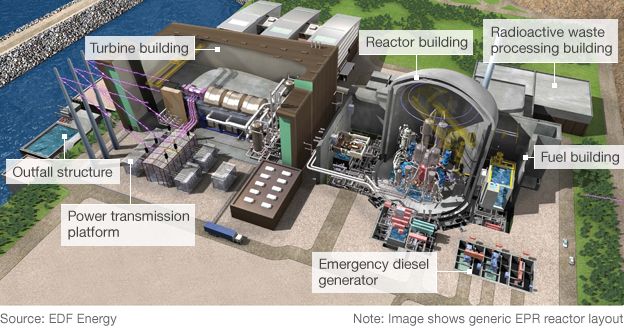New nuclear plant, Hinkley Point C, design unveiled
- Published

The design for the first UK nuclear power stations to be built for 25 years has been granted approval.
After a five-year process, regulators have said the European Pressurised Reactor, designed by two French firms, is safe and environmentally sound.
But there are still a number of hurdles to be cleared before energy supplier EDF and the nuclear engineering firm Areva can begin construction.
The firms are weighing up the economic case amid concerns about rising costs.
The French companies are looking at building two new plants at Hinkley Point in Somerset, but will need planning permission.
EDF Energy chief executive Vincent de Rivaz said: "The acceptance of the design for the EPR reactor is a major achievement and milestone for our new nuclear project in Somerset.
"It represents four years of hard work and allows our project to have a stable design before we start, offering a huge boost for the predictability of costs. It highlights our credibility and that of the EPR design, as well as demonstrating that the UK has a credible policy and regulatory framework in place."
Issues
In 2007, the Office for Nuclear Regulation and the Environment Agency began the process of examining four potential designs for new nuclear plants. But three of the applicants dropped out, leaving just the EPR.
The design has already been used for new reactors in Finland, France and China. But construction has taken longer than planned and costs continue to mount.
Last month, EDF revealed that the cost of its Flamanville EPR plant in Normandy had risen by more than 2bn euros (£1.8bn) due to design changes following the Fukushima nuclear disaster in Japan.
Last year, the UK regulators gave interim approval to the EPR under a process called the Generic Design Assessment, which aims to cut costs by examining new nuclear plans on paper rather than during the construction process.
But they said 31 issues must be addressed by EDF and Areva before approval could be granted.
Changes
As a result, there have been changes to the design, some of them due to lessons learnt from the Fukushima disaster.
"We asked them to look at the accident, why it came about.... and how that might affect the UK EPR," said Dave Watson of the Office for Nuclear Regulation.
That led to 16 changes, including additional flood protection measures and the provision of mobile generators and pumping equipment.
The regulators said the UK EPR was now "the most-assessed design ever" after a process costing £35m, which will be recouped from EDF and Areva.
EDF has still to confirm that it will go ahead with the investment in the new plan on its existing site in Somerset, to be known as Hinkley Point C.
A decision had been promised by the end of 2012, but the company has now revised that to "the earliest possible date".
Negotiations with the government over price guarantees for nuclear electricity could determine whether the company proceeds with its investment plans.
A decision on planning permission by the Planning Inspectorate is imminent, and the Secretary of State for Energy Ed Davey will then have three months to make his decision on final approval.
- Published6 December 2012
- Published3 December 2012
- Published29 November 2012
- Published23 November 2012
- Published11 December 2012
- Published29 November 2012